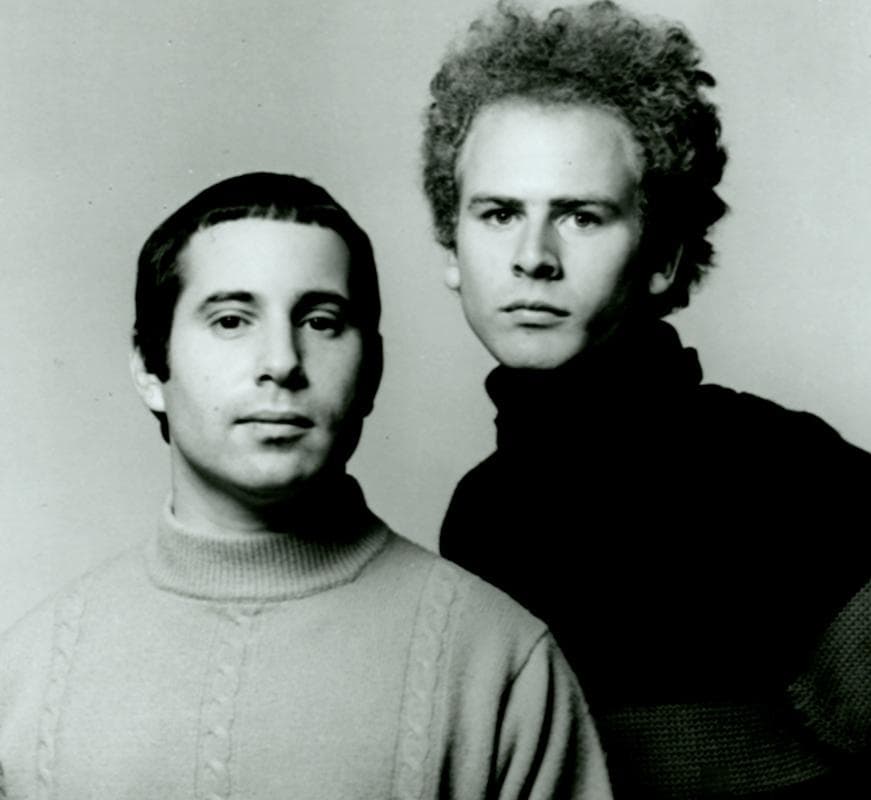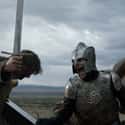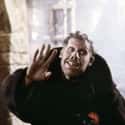-
(#1) Suits Of Armor Could Be Easily Punctured
In lots of medieval battle scenes, movies and TV shows will often make a suit armor look about as tough as Swiss cheese. In these scenes, like the one above from Game of Thrones, swords or arrows can easily punch through steel plate armor. This might have led you to wonder why knights wore armor if it was so easily penetrated.
But real armor was much more durable than Hollywood makes it look. Swords and arrows didn't effectively punch through high-quality armor, and soldiers sometimes carried smaller daggers that could be used to stab an enemy through the gaps in their armor. The biggest danger to an armored combatant wasn't piercing damage, but bludgeoning damage. Even if a knight was wearing a suit of armor, a heavy blow from a mace or club would still provide enough force to incapacitate them - and make them easier to capture and ransom.
-
(#2) Castle Sieges Took Place In A Matter Of Hours
Most movie depictions of castle sieges feel similar: A group of outnumbered defenders faces an overwhelming force with massive siege engines that can punch through castle walls in minutes. Once the defenses fall, fierce hand-to-hand fighting ensues until one side decisively wins. In reality, this has more to do with storytelling expediency than historical fact. If castle sieges were depicted realistically, they would take place over a period of several months.
Castles were built to give so many advantages to the defenders, such as moats, towers, and even artillery within the castle walls. Attacking a castle head-on, even with artillery and siege equipment, would have been both bloody and risky. The much safer bet was to encircle castles and wait until the defenders succumbed to hunger or thirst. The problem was, castles were built to counter this technique, as well. Many castles had their own water supplies and months of food stored up. Some were built at the sea's edge so that the castle could still be resupplied by boat, unless the attackers had their own naval force, as well. Certain castles even had secret passages and tunnels that could be used to smuggle people and goods in and out. And while an attacking army waited out the defenders, this made them vulnerable to counter-attack from reinforcements or from the defenders themselves.
-
(#3) Knights Often Perished In Battle
So many medieval movies and TV shows include battle scenes in which knights, the nobility, or even royals themselves are in mortal danger. Sometimes, two combatants in plate armor square off and bludgeon each other until one of them is done for. Other times, knights might get knocked off their horses and overwhelmed by a mob of foot soldiers, who then hack them apart.
In reality, while medieval warfare was plenty dangerous, a knight was one of the safest things to be. High-ranking combatants like knights and the nobility were usually the wealthiest people in society, which was how they could afford expensive, high-quality armor and weaponry in the first place. A captured knight or noble could be ransomed for a high price, whereas a deceased one was worth nothing. The Middle Ages were when the concept of a "prisoner of war" was first developed; ransoming prisoners became a routine part of warfare. Even if a knight hated their rival's guts, slaying them on the battlefield would have been a costly mistake.
One reason knights adopted heraldric styles for their suits of armor was to advertise their status as wealthy combatants, which would make them easier to identify as someone whose life was worth a lot of money.
-
(#4) Common Folk Were Always Dirty And Wore Drab-Colored Clothing
These stereotypes definitely come from our modern perspective. Medieval people didn't have access to running water, so we think they had no idea how to clean themselves. They also didn't live in a world with a global garment-manufacturing industry. Clothing had to be made from locally available materials by hand, so that means clothes were as simple and utilitarian as possible unless you were among society's wealthiest.
In reality, hygiene and clothing were both a lot more sophisticated than we think. Even though running water wasn't available, most towns were located near a freshwater source like a lake or river, making water accessible. Daily baths in a full bathtub were a luxury, but most people could bathe often by standing in a tub and pouring water on themselves, or by swimming. While bathing, medieval people could use soap or other alkaline substances to wash themselves. It was also common practice for people to wash their hands and faces first thing in the morning.
As for clothes, while most peasant clothing was made from coarse wool fabric, it wasn't always brown or gray. Clothing dyes were common. Blue was the most popular color for women's tunics, and other colors like pale yellow, green, and a red-orange were also available.
-
(#5) Commanders Yelled ‘Fire’ To Command Archers To Release Their Arrows
If you think about it, a commander telling their archers to shoot arrows by yelling "fire" makes no sense. Fire wasn't involved in the process at all, unless they were shooting fire arrows (which were rarely used on the battlefield, and usually only deployed against flammable villages). "Fire" has been the signal to shoot since the advent of gunpowder weapons, which use combustion to launch their projectiles. It sounds correct to a filmmaker who grew up in a world with gunpowder, but in a medieval movie it's an anachronism.
On an actual medieval battlefield, if commanders wanted their archers to shoot, they would yell, "Loose!" Which makes way more sense - to fire a bow, an archer first pulls the bowstring taught, then lets it "loose" to launch the arrow. And when commanders wanted to tell their archers to stop shooting, they would yell "fast," which originally meant "safe." This is also the origin of the phrase "playing fast and loose" to describe someone behaving recklessly.
-
(#6) Heavy Cavalry Would Charge Full Speed Into A Line Of Spears
In The Return of the King, the Riders of Rohan memorably charge headlong into a wall of orc spears. The scene is a lot of things - dramatic, exciting, heroic, suicidal - but it's not exactly accurate. Charging a several-hundred-pound horse into a sharpened weapon is going to end predictably, and most medieval commanders had much more sophisticated tactics.
The role of cavalry evolved throughout the Middle Ages. When it was first introduced during the fifth century, well-armored and equipped knights could effectively smash into a wall of poorly trained and armed peasants and rout them. But over time, infantry developed techniques to counter a frontal charge. Foot soldiers would group in tight formations and use spears or the newly invented pike to impale an oncoming cavalry charge. (Braveheart's depiction of the Battle of Stirling, and William Wallace's use of sharpened sticks to counter the English cavalry, is one of the rare details that movie got right.)
In return, mounted knights altered their tactics in several ways, like dismounting and engaging infantry on foot, using ranged weapons, or encircling the enemy and engaging at close range.
-
(#7) Everyone Had Terrible Table Manners
According to lots of movies set in the Middle Ages (or set in fantasy worlds based on medieval Europe), everyone was a total slob at the dinner table. Whenever there's a banquet, people invariably smear meat grease all over their faces, loudly slurp from their wine goblets, wipe their filthy hands on their clothes, throw bones on the floor, pick their noses, or sometimes all of the above.
Again, this comes from the Humanist tendency to look down on the Middle Ages. In reality, people were about as considerate as they are now. Good table manners were expected, both in terms of how people ate as well as how they conducted themselves. People did eat some of their meal with their hands, but this was because cutlery was rare. The only typical utensil was a knife that people would use to both carve meat and eat off of. Finger bowls with water would typically be provided, and diners would be expected to wash their hands before eating. Wealthy Europeans would sometimes employ servants called ewerers, who would carry napkins for their lords' use.
-
(#8) Peasants Had Bad Teeth
Modern dentistry didn't start to develop until the 18th century, but it's not as if everyone's teeth were in terrible shape before then. In the Middle Ages, both the peasant and wealthy classes knew the importance of regular dental hygiene. Medieval movies often portray peasants as people with mouths full of rotting teeth, but if anything, it was more likely to be the wealthy who suffered from dental problems. The wealthiest medieval Europeans ate much more sugar in their diets than peasants, and thus had higher rates of tooth decay.
Recent analysis of medieval manuscripts has also shown that dental practices were much more advanced than we might think. The importance of keeping the teeth clean was known, and there were rudimentary procedures for filling cavities, whitening teeth, and fixing fractures. Medieval surgeons also had ways to perform dental surgery, construct dentures made of human teeth or cow bones, and treat oral cancer. Of course, like sugar, most of these dental treatments would have been available only for the wealthiest.
-
(#9) Children Never Played And Worked Hard All The Time
Childhood in the Middle Ages was brutal, at least the way modern people think of it. It's well known that education was reserved for only the wealthiest children in society, which meant the average peasant child was put to work. Given that, it's easy to conclude that children's lives were nothing but work, and that they didn't have actual childhoods. It's also assumed that parents treated their children like tiny adults, and that parental love is a modern invention.
It's true that childhood in the Middle Ages was much different from childhood today, and the use of child labor was the norm in medieval Europe. But actual historical evidence shows that medieval children did occasionally get to be kids. Archeologists have discovered numerous medieval toys, like miniature knights, dolls, and cooking pans. Children played all sorts of games, from stick-and-ball sports to board games like chess and backgammon.
And while it's difficult to know for certain what emotions parents felt about their children centuries ago, numerous examples of parental love have survived to the present, like lullabies, poems, and grave inscriptions.
-
(#10) All Castles Were Made Out Of Stone And Were Built To Last Forever
Another misconception about the Middle Ages is that castles were always huge, imposing fortresses, and were always built out of stone. In reality, those are just the castles that have survived to the present day.
In a pre-industrial society that relied on manual labor, building anything out of stone was expensive, time-consuming, and labor-intensive. Wood, which was much cheaper and more readily available, was used to build the first castles. The earliest castles were built in the motte-and-bailey style. The "motte" was an earthen mound on top of which a wooden keep was built, and the "bailey" was the structure's outer wall, also built out of timber. Motte-and-bailey fortifications first appeared in the 11th century and were the most popular castle style for the next 200 years. As the original wooden structures began to rot, and as siege weapons became more powerful, castle engineers began incorporating stone into their designs. But this was a gradual process, and full stone castles didn't become common until the 13th century.
-
(#11) People Were Terrified Of Witchcraft, And Witch Hunts Were Common
The scene from Monty Python and the Holy Grail in which Sir Bedivere puts an accused witch on trial is probably the most responsible for the misconception that medieval Europe was gripped with witch panic. Supposedly, peasants were so ignorant of science and nature that whenever disaster would strike, witchcraft was the only possible explanation. And a single woman, already suspicious, made for a convenient scapegoat. But that would be a more accurate description of the Renaissance and Englightenment-era Europe than the Middle Ages.
For most of the medieval period, specifically 900 to 1400 A.D., the Catholic church actually denied the existence of witches, which meant it rarely prosecuted people for witchcraft. Pope Alexander IV even outlawed witch hunts in 1258. It was only after the Protestant Reformation that persecuting witches became common. In Europe between 1560 and 1630, there were over 80,000 accusations of witchcraft, and 40,000 people were executed.
There are many theories for why witch hunts became more common during this period, but one explanation is that it was a way for the Catholic and Protestant churches to compete for followers. By building up Satan and witches as an enemy, both churches could then claim to be the best protectors against evil.
-
(#12) People Spoke Modern English
Almost every movie set in medieval England depicts every medieval Brit speaking the English language, using the same vocabulary, grammar, and sometimes even the same slang that we use today. It's particularly egregious in movies about people from the present who travel back in time to the Middle Ages. We're not asking for a time travel movie to be 100% factually accurate. We'd just like to point out that if you could travel back to 11th-century England, people would have no way of understanding you - and vice versa.
In medieval England, people used three main languages: Latin, which was used in church, but also was used for secular administration and record-keeping, as well as in everyday life; Anglo-Norman, a French dialect used mainly by the upper classes that originated with the Norman Conquest of 1066; and Middle English.
Understanding a Middle English speaker wouldn't be entirely impossible for a modern person, but the differences in pronunciation, vocabulary, and spelling would make most communication a challenge. To get an idea of how difficult it would be, you can try reading The Canterbury Tales.
New Random Displays Display All By Ranking
About This Tool
Our data comes from Ranker, If you want to participate in the ranking of items displayed on this page, please click here.






















